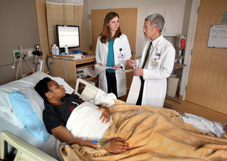Army physicians on the front line of infectious disease research
Walter Reed's infectious disease unit travels the globe to identify and combat the world's deadliest infectious diseases. Driven to find vaccines that protect troops stationed overseas, the work quickly benefits civilian populations, too.
Col. Gray Heppner, FACP, rolled up his sleeve for the needle prick as a volunteer in a trial for a new malaria vaccine. It was 1992, and he underwent the challenge along with 16 other vaccinated volunteers by putting his arm on a mesh-covered cardboard container of mosquitoes infected with falciparum malaria.
Col. Heppner is deputy commander of the Walter Reed Army Institute of Research (WRAIR), where he and a half-dozen ACP Fellows work alongside hundreds of others who have played a vital role in development of the RTS,S malaria vaccine now being tested in Africa, including taking a chance on a test vaccine to see how effectively it would work. It didn't, and Col. Heppner subsequently suffered with the flu-like symptoms of the disease.

His illness was treated with effective drugs that are not readily available to the millions of people afflicted with malaria in sub-Saharan Africa, where one in five children die because of the disease. The scenario is one part of WRAIR's mission to research emerging infectious diseases around the globe.
For example, WRAIR operates several laboratories and clinical facilities in partnership with the governments of Thailand and Kenya and has field operations in 40 countries around the world. Its physicians and researchers cross paths with a growing network of U.S. physicians who also devote time, effort and resources to finding solutions and providing care for people who suffer from these devastating diseases.
WRAIR's work
WRAIR is a 2,000-person, $220 million-a-year global research enterprise commanded by Col. Kent E. Kester, FACP, a malaria vaccine researcher and infectious disease physician. The outfit's interest in malaria started when deployed American soldiers were sickened by and died of the disease. Development of vaccines has long been a priority for the Army and the U.S. Department of Defense. The first U.S.-licensed vaccine that the Army helped develop was for influenza after the pandemic killed one of every 67 servicemen in World War I.
As an example of potential careers at WRAIR, Col Kester cited the experience of Col. Peter Weina, FACP. “Where else could a young physician become a recognized specialist conducting global field trials in malaria, establish the only College of American Pathologists-certified diagnostic leishmaniasis laboratory in the U.S., and earn the Bronze Star for taking care of soldiers in Iraq afflicted by leishmaniasis and other infectious diseases?”
In addition to the influenza vaccine in 1945, vaccines attributed at least in part to the collaboration of military physicians and scientists include ones for rubella in 1969; adenovirus types 4 and 7 in 1980 and 2008; meningococcus A, C, Y, W-135 and hepatitis B in 1981; oral typhoid in 1989; Japanese encephalitis in 1992 and 2009; and hepatitis A in 1995.
Although it focuses on diseases that could sicken American soldiers, WRAIR's vaccine development program ultimately benefits people in the countries at greatest risk of these diseases. Recent work on the RTS,S malaria vaccine has taken place at WRAIR's laboratory in Nairobi, Kenya. The lab was initially a platform to investigate African sleeping sickness, but it is now working on development of the malaria vaccine, as well as one for HIV.
The Nairobi lab is a major part of an international malaria vaccine partnership, and it receives funding from GlaxoSmithKline and the Bill and Melinda Gates Foundation for ongoing phase 3 trials of the RTS,S malaria vaccine that its developers hope will be approved for use in children. One million young children die from malaria each year.
WRAIR also developed an intravenous form of artesunate for treatment of severe malaria in patients too sick to take pills. Recommended by the World Health Organization, artesunate had been available in other countries but not in the U.S. WRAIR conducted trials on IV artesunate in Thailand and Kenya, and the drug has now been approved on a compassionate use basis in this country for patients who require IV treatment. WRAIR has provided a supply of the drug to the CDC for release to hospitals under an investigational new drug application, and is working on final FDA approval.
WRAIR is also focused on development of a preventive vaccine for dengue fever, a disease of the tropics that can impact American soldiers, and it is developing vaccines for the major causes of diarrhea in American military deployed in other countries: enterotoxigenic Escherichia coli, Campylobacter jejuni, and Shigella flexneri and Shigella sonnei.
HIV/AIDS work
The Military HIV Research Program (MHRP) at WRAIR, directed by Col. Nelson Michael, FACP, aims to develop a globally effective HIV vaccine. The program also provides prevention education and antiretroviral therapy through the President's Emergency Plan for AIDS Relief (PEPFAR) in four African nations where the program conducts clinical research studies.
MHRP recently led a clinical trial in Thailand involving more than 16,000 adult volunteers which showed for the first time that an investigational HIV vaccine regimen was safe and provided a modest effect on reducing the rate of HIV infection compared to placebo. This trial was conducted by the Thai Ministry of Public Health in collaboration with a team of leading Thai and U.S. researchers. The Army-sponsored trial was funding by the National Institute of Allergy and Infectious Diseases (NIAID), NIH, and the U.S. Army.
Given the threat of HIV infection worldwide, an efficacious vaccine is urgently needed as part of a broader prevention effort to help control the epidemic.
“We now have evidence that a safe and effective HIV vaccine is possible, and the results should accelerate research efforts towards a more effective vaccine,” said Col. Michael. “We all have much more work to do, but the door is now open.”
William M. Tierney, MACP, is involved in a long-term partnership between Indiana University and Moi University in Kenya that is also allied with WRAIR on clinical research of drugs for AIDS. As director of research for the Indiana University-Kenya Program, Dr. Tierney has traveled to that country 33 times over the past 11 years.
According to Dr. Tierney, Chancellor Professor at Indiana University's School of Medicine, Kenyans were not talking about HIV about 10 years ago and no diagnoses were being made. “HIV was not recorded in a patient record because of the stigma, and no one was tested for it because there was no treatment. Why test for such a stigmatizing disease if there is no treatment? And because there was no treatment, the hospitals were half-filled with children and young adults dying of AIDS,” he said.
But when a treatment program opened in 2001, “people started coming out of the woodwork, were tested, and enrolled into treatment programs.”
One site in Dr. Tierney's program in Kenya is about 60 miles from a WRAIR research lab. “We are directly partnering with [WRAIR] on clinical research trials of AIDS drugs. The people connected with WRAIR are clearly there for the long haul. In early 2008, when there was violence there, some of the WRAIR complex was attacked, but no one wanted to evacuate. They essentially had to drag those people out of there because they are so dedicated.”
He and Indiana University's Regenstrief Institute have created and implemented an open-source electronic medical record system to guide and manage HIV/AIDS care. The system tracks patient treatment and provides information to doctors and nurses at the point of care, where it is most needed, Dr. Tierney said. The electronic system now includes more than 60 million observations from more than 2 million office visits for 130,000 patients, more than 100,000 of whom are infected with HIV and receive care at 46 sites in western Kenya.
An EMR system that gives reminders about when to give specific AIDS tests and medications has improved adherence to guidelines by 50%, Dr. Tierney said.




